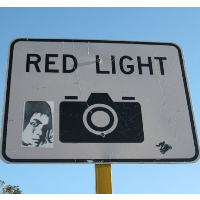New San Diego Mayor Turns off “Traffic Trap” Red-Light Cameras

You no longer have to smile for the camera if you’re running a red light in San Diego.
Newly-elected Mayor Bob Filner announced last week that he was ending the controversial “traffic trap” program begun in 1998, and on Friday the cameras were turned off at 15 intersections throughout the city. “This is not the way to enforce the traffic laws or teach people about the traffic laws,” Filner said. “The best deterrent is a police officer, writing citations and talking to citizens.”
The cameras, operated under contract by an independent company, captured images of 4,000 potential violators every month, generating income for the city and raising the ire of motorists. The cameras automatically snapped pictures of license plates and occupants when vehicles were perceived to be running a red light, and reportedly accounted for 25% of traffic citations issued in 2011.
U-T San Diego reported that 20,000 tickets were mailed out per year, each costing $490. But the city’s take was only a fraction of the amount collected. After subtracting the county and state’s share of the revenues, payment for the officers handling the ticket process, fees to the camera vendor and other assorted costs, the city netted about $200,000 a year.
An unscientific poll by the newspaper found that 82% of San Diego residents wanted to end the program. The previous mayor, Jerry Sanders, indicated in September an intention to expand the controversial program, but did not before leaving office in January.
Cities in California were among the first in the nation to use red-light cameras when Oxnard installed them in 1996. But as the cameras have come under scrutiny and criticism, cities have been pulling the plug on them. At least 10 California cities, including Pasadena, bailed in the first half of the year.
A bill to limit the use of the cameras by cities and counties, Senate Bill 1303, was passed by the Legislature in 2012, and signed by Governor Jerry Brown. The law makes it easier to challenge a ticket and restrains cities and counties from deploying the cameras just to raise revenues. It also clarifies conflicting court rulings by specifying that evidence from red-light cameras is not hearsay, and can be used in court.
Proponents of red-light cameras say they deter motorists from running red lights, cut down on traffic accidents and free up police. Detractors say the system does none of that. Instead, they argue: Almost all the tickets are for rolling stops that endanger no one; motorists surprised by a flashing camera are more likely to cause an accident; police are still tied up in court when the tickets are contested; and car owners are often incorrectly identified as drivers because of poorly positioned cameras.
The cameras have engendered dozens of competing studies that alternately claim stunning success and miserable failure.
–Ken Broder
To Learn More:
San Diego Drops Red-Light Cameras (by Matt Clark, U-T San Diego)
San Diego Mayor Ends Use of Red-Light Cameras at Intersections (by Tony Perry, Los Angeles Times)
Pasadena Turns off Red-Light Cameras that Didn’t Put the City in the Black (by Ken Broder, All Gov California)
- Top Stories
- Controversies
- Where is the Money Going?
- California and the Nation
- Appointments and Resignations
- Unusual News
- Latest News
- California Forbids U.S. Immigration Agents from Pretending to be Police
- California Lawmakers Urged to Strip “Self-Dealing” Tax Board of Its Duties
- Big Oil’s Grip on California
- Santa Cruz Police See Homeland Security Betrayal in Use of Gang Roundup as Cover for Immigration Raid
- Oil Companies Face Deadline to Stop Polluting California Groundwater





